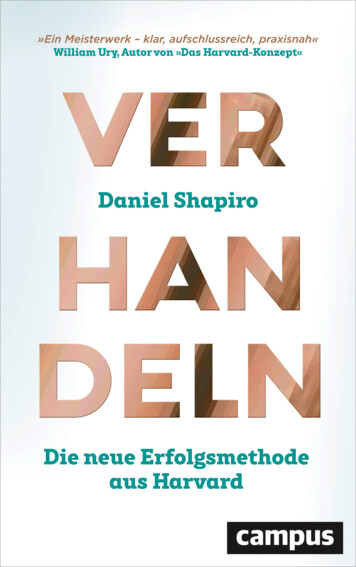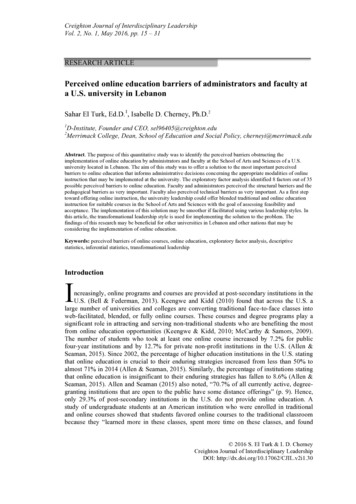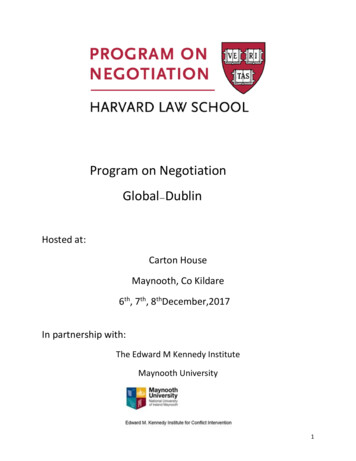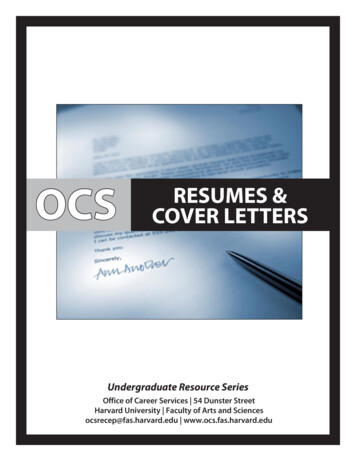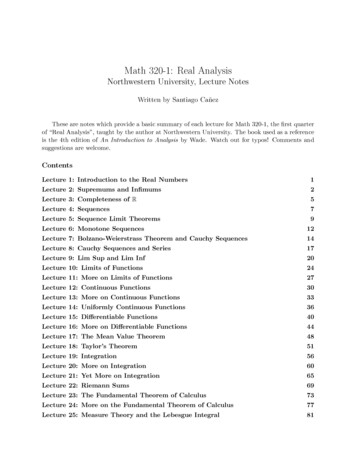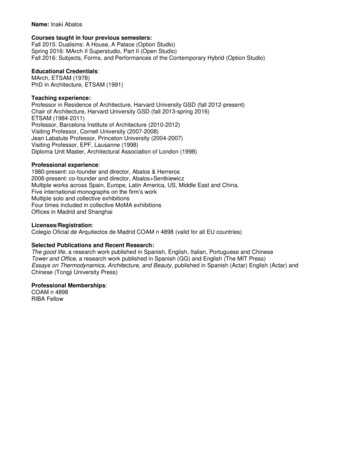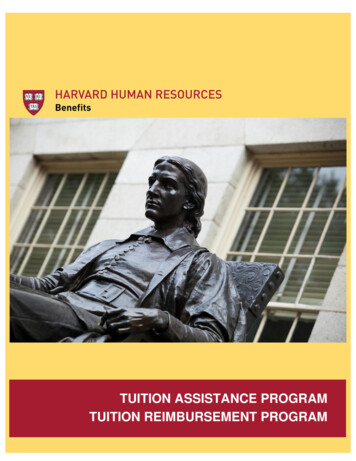
Transcription
Real AnalysisCourse NotesC. McMullenContents12345678910111213A1Introduction . . . . . . . . . . . . . . . . .Set Theory and the Real Numbers . . . .Lebesgue Measurable Sets . . . . . . . . .Measurable Functions . . . . . . . . . . .Integration . . . . . . . . . . . . . . . . .Differentiation and Integration . . . . . .The Classical Banach Spaces . . . . . . .Baire Category . . . . . . . . . . . . . . .General Topology . . . . . . . . . . . . . .Banach Spaces . . . . . . . . . . . . . . .Fourier Series . . . . . . . . . . . . . . . .Harmonic Analysis on R and S 2 . . . . . .General Measure Theory . . . . . . . . . .Measurable A with A A uctionWe begin by discussing the motivation for real analysis, and especially forthe reconsideration of the notion of integral and the invention of Lebesgueintegration, which goes beyond the Riemannian integral familiar from classical calculus.1. Usefulness of analysis. As one of the oldest branches of mathematics,and one that includes calculus, analysis is hardly in need of justification.But just in case, we remark that its uses include:1. The description of physical systems, such as planetary motion, bydynamical systems (ordinary differential equations);2. The theory of partial differential equations, such as those describingheat flow or quantum particles;3. Harmonic analysis on Lie groups, of which R is a simple example;4. Representation theory;1
5. The description of optimal structures, from minimal surfaces to economic equilibria;6. The foundations of probability theory;7. Automorphic forms and analytic number theory; and8. Dynamics and ergodic theory.2. Completeness. We now motivate the need for a sophisticated theoryof measure and integration, called the Lebesgue theory, which will form thefirst topic in this course.In analysis it is necessary to take limits; thus one is naturally led tothe construction of the real numbers, a system of numbers containing therationals and closed under limits. When one considers functions it is againnatural to work with spaces that are closed under suitable limits. For example, consider the space of continuous functions C[0, 1]. We might measurethe size of a function here byZ 1kf k1 f (x) dx.0(There is no problem defining the integral, say using Riemann sums).But we quickly see that there are Cauchy sequences of continuous functions whose limit, in this norm, are discontinuous. So we should extendC[0, 1] to a space that is closed under limits. It is not at first even evidentthat the limiting objects should be functions. And if we try to include allfunctions, we are faced with the difficult problem of integrating a generalfunction.The modern solution to this natural issue is to introduce the idea ofmeasurable functions, i.e. a space of functions that is closed under limits andtame enough to integrate. The Riemann integral turns out to be inadequatefor these purposes, so a new notion of integration must be invented. In factwe must first examine carefully the idea of the mass or measure of a subsetA R, which can be though of as the integral of its indicator functionχA (x) 1 if x A and 0 if x 6 A.3. Fourier series. More classical motivation for the Lebesgue integralcome from Fourier series.Suppose f : [0, π] R is a reasonable function. We define the Fouriercoefficients of f byZ2 πan f (x) sin(nx) dx.π 02
Here the factor of 2/π is chosen so thatZ2 πsin(nx) sin(mx) dx δnm .π 0We observe that iff (x) Xbn sin(nx),1then at least formally an bn (this is true, for example, for a finite sum).This representation of f (x) as a superposition of sines is very useful forapplications. For example, f (x) can be thought of as a sound wave, wherean measures the strength of the frequency n.Now what coefficients an can occur? The orthogonality relation impliesthatZ X2 π an 2 . f (x) 2 dx π 0 PThis makes it natural to ask if, conversely, for any an such that an 2 ,there exists a functionP f with these Fourier coefficients. The natural functionto try is f (x) an sin(nx).But why should thiseven exist? The functionsPsin(nx) are onlyP sumbounded by one, and an 2 is much weaker than an .One of the original motivations for the theory of Lebesgue measure andintegration was to refine the notion of function so that this sum reallydoes exist. The resulting function f (x) however need to be Riemann integrable! To get a reasonable theory that includes such Fourier series, Cantor,Dedekind, Fourier, Lebesgue, etc. were led inexorably to a re-examinationof the foundations of real analysis and of mathematics itself. The theorythat emerged will be the subject of this course.Here are a few additional points about this example.First, we could try to define the required space of functions — calledL2 [0, π] — toR simply2be the metric completion of, say C[0, π] with respectto d(f, g) f g . The reals are defined from the rationals in a similarfashion. But the question would still remain, can the limiting objects bethought of as functions?PSecond, the set of point E R wherean sin(nx) actually converges isliable to be a very complicated set — not closed or open, or even a countableunion or intersection of sets of this form. Thus to even begin, we must havea good understanding of subsets of R.Finally, even if the limiting function f (x) exists, it will generally not beRiemann integrable. Thus we must broaden our theory of integration to3
deal with such functions. It turns out this is related to the second point —we must again find a good notion for Rthe length or measure m(E) of a fairlygeneral subset E R, since m(E) χE .2Set Theory and the Real NumbersThe foundations of real analysis are given by set theory, and the notion ofcardinality in set theory, as well as the axiom of choice, occur frequently inanalysis. Thus we begin with a rapid review of this theory. For more detailssee, e.g. [Hal]. We then discuss the real numbers from both the axiomaticand constructive point of view. Finally we discuss open sets and Borel sets.In some sense, real analysis is a pearl formed around the grain of sandprovided by paradoxical sets. These paradoxical sets include sets that haveno reasonable measure, which we will construct using the axiom of choice.The axioms of set theory. Here is a brief account of the axioms. Axiom I. (Extension) A set is determined by its elements. That is, ifx A x B and vice-versa, then A B. Axiom II. (Specification) If A is a set then {x A : P (x)} is also aset. Axiom III. (Pairs) If A and B are sets then so is {A, B}. From thisaxiom and 0, we can now form {0, 0} {0}, which we call 1; andwe can form {0, 1}, which we call 2; but we cannot yet form {0, 1, 2}.S Axiom IV. (Unions) If A is a set, then A {x : B, B A & x B}of pairs we can formS is also a set. From this axiom and that {A, B} A B. Thus we can define x x 1 x {x}, andform, for example, 7 {0, 1, 2, 3, 4, 5, 6}. Axiom V. (Powers) If A is a set, then P(A) {B : B A} is also aset. Axiom VI. (Infinity) There exists a set A such that 0 A and x 1 Awhenever x A. The smallest such set is unique, and we call itN {0, 1, 2, 3, . . .}. Axiom VII (The Axiom of Choice): For any set A there is a functionc : P(A) { } A, such that c(B) B for all B A.4
Cardinality. In set theory, the natural numbers N are defined inductivelyby 0 and n {0, 1, . . . , n 1}. Thus n, as a set, consists of exactly nelements.We write A B to mean there is a bijection between the sets A andB; in other words, these sets have the same cardinality. A set A is finite if A n for some n N; it is countable if A is finite or A N ; otherwise,it is uncountable.A countable set is simply one whose elements can be written down ina (possibly finite) list, (x1 , x2 , . . .). When A N we say A is countablyinfinite.Inequalities. It is natural to write A B if there is an injective mapA , B. By the Schröder–Bernstein theorem (elementary but nontrivial),we have A B and B A A B .The power set. We let AB denote the set of all maps f : B A. Thepower set P(A) 2A is the set of all subsets of A. A profound observation,due to Cantor, is that A P(A) for any set A. The proof is easy: if f : A P(A) were a bijection, we couldthen form the setB {x A : x 6 f (x)},but then B cannot be in the image of f , for if B f (x), then x B iffx 6 B.Russel’s paradox. We remark that Cantor’s argument is closely relatedto Russell’s paradox: if E {X : X 6 X}, then is E E? Note that theaxioms of set theory do not allow us to form the set E!Countable sets. It is not hard to show that N N is countable, andconsequently:A countable union of countable sets is countable.Thus Z, Q and the set of algebraic numbers in C are all countable sets.Remark: The Axiom of Choice. Recall this axiom states that for anyset A ,there is a map c : P(A) { } A such that c(A) A. This axiomis often useful and indeed necessary in proving very general theorems; forexample, if there is a surjective map f : A B, then there is an injectivemap g : B A (and thus B A ). (Proof: set g(b) c(f 1 (b)).)Another typical application of the axiom of choice is to show:5
Every vector space has a basis.To see this is nontrivial, consider the real numbers as a vector space over Q;can you find a basis?The real numbers. In real analysis we need to deal with possibly wildfunctions on R and fairly general subsets of R, and as a result a firm grounding in basic set theory is helpful. We begin with the definition of the realnumbers. There are at least 4 different reasonable approaches.The axiomatic approach. As advocated by Hilbert, the real numbers canbe approached axiomatically, like groups or plane geometry. Accordingly,the real numbers are defined as a complete, ordered field. Note that in afield, 0 6 1 by definition.A field K is ordered if it is equipped with a distinguished subset K thatis closed under addition and multiplication, such thatK K t {0} t ( K ).It is complete if every nonempty set A K that is bounded above has aleast upper bound, which is denoted sup A K.Least upper bounds, limits and events. If we extend the real line byadding in , then any subset of R has a natural supremum. For example,sup Z and sup . The great lower bound for A is denoted byinf A.From these notions we can extract the usual notion of limit in calculus,together with some useful variants. We first note that monotone sequencesalways have limits, e.g.:If xn is an increasing sequence of real numbers, then xn sup(xn ).We then define the important notion of lim-sup by:lim sup xn lim sup xn .N n NThis is the limit of a decreasing sequence, so it always exists. The liminf isdefined similarly, and finally we say xn converges iflim sup xn lim inf xn ,in which case their common value is the usual limit, lim xn .For example, (xn ) (2/1, 3/2, 4/3, 5/4, .) has lim sup xn 1 eventhough sup xn 2.6
The limsup and liminf of a sequence of 0’s and 1’s is again either 0 or 1.Thus given a sequence of sets Ei R, there is a unique sets lim sup Ei suchthatχlim sup Ei lim sup χEi ,and similarly for lim inf Ei . In factlim sup Ei {x : x Ei for infinitely many i},whilelim sup Ei {x : x Ei for all i from some point on}.These notions are particularly natural in probability theory, where we thinkof the sets Ei as events.Consequences of the axioms. Here are some first consequences of theaxioms.1. The real numbers have characteristic zero. Indeed, 1 1 · · · 1 n 0 for all n, since R is closed under addition.2. Given a real number x, there exists an integer n such that n x.Proof: otherwise, we would have Z x for some x. By completeness,this means we have a real number x0 sup Z. Then x0 1 is not anupper bound for Z, so x0 1 n for some n Z. But then n 1 x0 ,a contradiction.3. Corollary: If 0 then 1/n 0 for some integer n.4. Any interval (a, b) contains a rational number p/q. (In other words, Qis dense in Q.)Constructions of R. To show the real numbers exist, one must constructfrom first principles (i.e. from the axioms of a set theory) a field with therequired properties. Here are 3 such constructions.Dedekind cuts. One can visualize a real number x as a cut that partitionsthe rational numbers into 2 sets,A {r Q : r x} and B {r Q : r x}.Thus one can define R to consists of the set of pairs (A, B) forming partitionsof Q into nonempty sets with A B, such that B has no least element. Thelatter convention makes the cut produced by a rational number unique.7
Dedekind cuts work well for addition: we define (A, B) (A0 , B 0 ) (A A0 , B B 0 ). Multiplication is somewhat trickier, but completenessworks fairly well. As a first approximation, one can define[\sup(Aα , Bα ) ( Aα , Bα ).TThe problem here is that when the supremum is rational, the set Bαmight have a least element. (This suggest it might be better to introducean equivalence relation on cuts, so that the ‘two versions’ of each rationalnumber are identified.)The extended reals R are also nicely constructed using Dedekindcuts, by allowing A or B to be empty. We will often implicitly use theextended reals, e.g. by allowing the value of a sum of positive numbers tobe infinite rather than simply undefined.For more on the efficient construction of R using Dedekind cuts, see[Con, p.25].Remark: Ideals. Dedekind also proposed the notion of an ideal I in thering of integers A in a number field K. The elements n A give principalideals (n) A consisting of all the elements that are divisible by n. Idealswhich are not principal can be thought of as ‘ideal’ integers, which do notbelong to A but which can be seen implicitly through
and constructive point of view. Finally we discuss open sets and Borel sets. In some sense, real analysis is a pearl formed around the grain of sand provided by paradoxical sets. These paradoxical sets include sets that have no reasonable measure, which we will construct using the axiom of choice. The axioms of set theory. Here is a brief account of the axioms.


